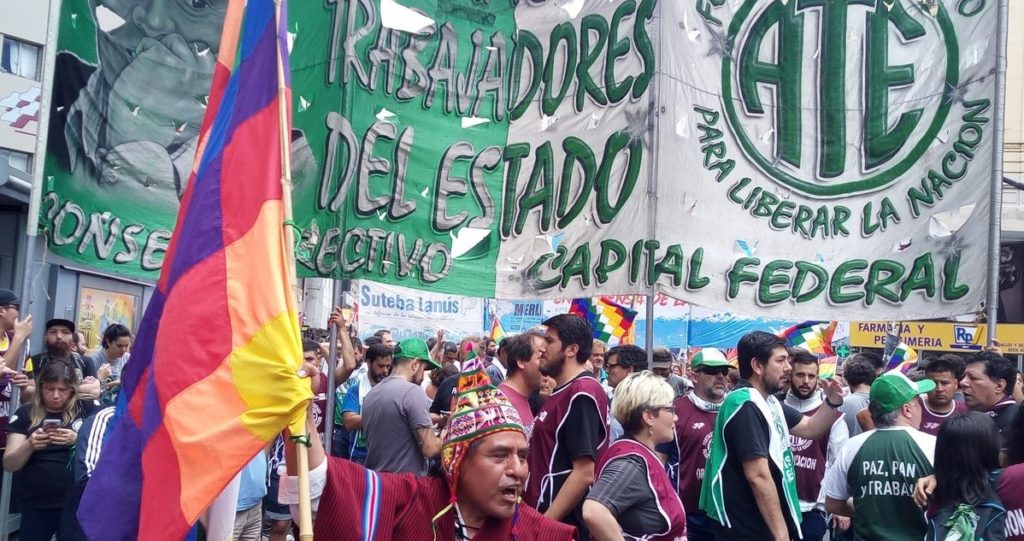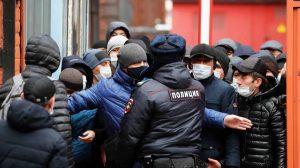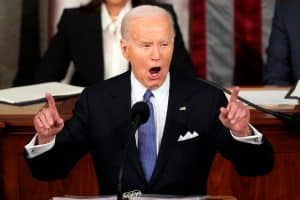The eruption of the mass movement is contagious. Some of that can be seen this week in the important day of work stoppages and massive mobilizations in Colombia. The militarization, closing of borders, and the whole of Colombian President Ivan Duque’s fear campaign all failed. Workers, students, and the popular sectors took to the country’s streets. In Chile, the argument for imposing a rigged constituent assembly continues, along with the repression—the methods of which have been increasingly exposed internationally—and political persecution. Meanwhile, a broad vanguard has led important days of struggle and mobilization, and a new general strike is being prepared.
Bolivia, without a doubt, marks the most acute confrontations of the class struggle. This week the great protagonist was the resistance to the coup. The members of parliament from Evo Morales’ MAS have dedicated themselves to negotiating with their opponents to validate the coup. The leadership of the Central Obrera Boliviana (COB, the country’s main trade union federation) has folded into the coup mentality. But at the same time, an important vanguard sector of peasants, workers, youth, and native peoples carried out heroic days of struggle that set a first limit on the coup plotters in terms of the relationship of forces. This has been centered in the city of El Alto—where thousands of peasants from the city of Potosí arrived in support—along with some particular resistance sites in the city of Cochabamba.
While these processes of the class struggle are going through different stages, all signs indicate that they are here to stay. Unlike the previous cycle in Latin America, in which shifts in the situation—either to the right or to the left—seemed to evolve, the current scenario in the region is marked by abrupt changes in the relationship of forces. Eruptions of the masses can give rise to revolutionary situations or be diverted, even giving rise to reaction and civilian-military coups, as in Bolivia. They can end up awakening heroic resistance that raises the potential for revolutionary/counterrevolutionary clashes.
In this scenario, many of the current processes come to the same crossroads, where what is posed is how to go beyond the level of just resistance or acts of extreme pressure. One of the great stumbling blocks along this road is that the working class, which controls the “strategic positions” that make society work (transport, major industries and services), is divided and constricted by different bureaucracies that, with occasional exceptions, prevent it from using this power that makes the class capable of decisively breaking the bourgeois order. Instead, the bureaucracy intervenes generally among “the people.”
In Bolivia, if we take the COB as our reference, we see its leadership plainly sticking close to the coup plotters’ orbit. There is, however, a sector of the population of El Alto—whose residents are largely precarious workers, those in the formal sector, freelancers, and even some peasants in certain neighborhoods—that has shown tremendous guts, drawing on old traditions and the experiences of emblematic struggles, such as the 2003 “Gas War.”1Translator’s note: In 2003, the so-called Gas War was part of ongoing protests over capitalist exploitation of Bolivia’s vast natural gas reserves. It culminated in October with strikes and barricades in the streets that brought the country to a standstill—and which was met by violent repression that included the murder of some 60 people by the army, mostly in El Alto. This sector has been searching for strategic points where it can break the resistance of the coup plotters—such as the Senkata fuel plant in El Alto. This offers an important lesson in strategy.
Senkata as a Turning Point for Resistance
In a previous article, we asked the following: If the events of October 2003—the struggle at Senkata and its fuel distribution plant, the shortages, the deployment of the general strike, the peasant blockades, and so on—could succeed in toppling then President Sánchez de Lozada, then how long would the coup government of Jeanine Áñez last with such a strike? Today the conditions are much more unfavorable than they were 16 years ago, with the COB endorsing the coup, the MAS negotiating with Áñez, the middle classes on the opposite side of the streets, and many of the protagonists from back then now demobilized. But last week, while we didn’t see a deployment like that of 2003, we did have a small show of force that was nevertheless heroic.
The Senkata plant of Yacimientos Petrolíferos Fiscales Bolivianos (YPFB), located in El Alto’s District 8, is a strategic point. The entire department of La Paz—Bolivia’s political center, where a considerable part of the country’s population and economic activity are concentrated—depends on the plant for its supply of gasoline and liquefied gas. It’s no coincidence that during the “Gas War,” the Sánchez de Lozada government concentrated all its forces (police and army) to break the isolation of La Paz and reopen the fuel supply by unblocking the Senkata plant. An offensive was carried out on October 11 and 12 of that year had to confront the enormous resistance of the people of El Alto, along with the Huanuni tin miners and the peasants. Despite the repression that left at least 26 dead, the military raid was defeated, and the insurrection-like uprising deepened and spread to the poor neighborhoods of La Paz. A few days later, Sánchez de Lozada was ousted.
Last week, Senkata’s ghost returned to haunt the occupants of the Palacio Quemado (Bolivia’s official presidential residence)—now the coup government headed by Áñez. The blockades that had been erected, including deep potholes on the roads aimed at impeding truck traffic, directly posed the threat of shortages and put a crack in the image of “normalcy” the coup government had tried to push in order to stabilize itself. On November 19, hundreds of soldiers and police—with tanks, helicopters, and other military vehicles—brutally repressed the El Alto residents’ blockade. The resistance made itself felt: The clashes spread throughout District 8 and won support from several other districts for much of the day. It was only through a tremendously repressive deployment, one that left nine people dead, that the government managed to bring out 50 gasoline tankers and 10 trucks with liquefied gas (a supply sufficient for just over two days of average consumption in La Paz). Some 10 military tanks escorted them, along with army planes—shooting at the population—and 25 police vans and vehicles of the intelligence agencies.
The next day, thousands of people came to Senkata from throughout El Alto for a massive town hall. A column of demonstrators arrived from Potosí, and representatives also came from the 20 provinces of the department of La Paz. By acclamation, this gathering called for the resignation of the self-proclaimed president Áñez and the entire country to fight the coup. On November 21, a crowd mobilized to carry the dead from Senkata to La Paz; the army and police were put in charge of repressing the march, demonstrating the dictatorship’s racist contempt for the people. At the same time, as bulldozers advanced against the blockades in the Senkata area to open the road leading to the fuel plant, other districts were erecting blockades in El Alto, and activities grew more radical.
The MAS members of parliament used the relationship of forces imposed by these actions—which had not existed a week earlier—to negotiate with the de facto government, legitimize it, and agree to an election “accord,” thus betraying the struggle to defeat the coup. Finally, on November 23, deliveries from Senkata plant returned to normal. That fact, though, does not diminish the strategic lesson provided by the resistance and blockade of Senkata.
Strategic Positions
From the point of view of the struggle against the coup in Bolivia, Senkata’s blockade showed a concrete example of the strength of the mass movement acting on strategic points to target and modify the relationship of forces. The bourgeoisie itself, in the words of the daily Página Siete, lamented, “Why wasn’t a new plant built [after 2003] or at least an emergency one?” and pleaded for a stop to “continued consideration that the Senkata plant can be used to suffocate La Paz.”
In this instance, the residents of El Alto had to use blockades exclusively, under conditions marked by nothing less than the COB leadership’s having situated itself within the camp of the coupists. But raising the importance of controlling such strategic points illustrates the potential for the class struggle when the working class holds “from within” all the fundamental “strategic positions” in production, distribution, and services. In this sense, Senkata provides a specific example of the kind of power in general—not limited to this or that strategic point—that the working class potentially has to paralyze in Bolivia the entirety of the gas industry, mining, airports, and so on. Of course, the more strategic points the working class manages to interfere with simultaneously, the more decisive will be the power it deploys.
Historian John Womack Jr. defines the “strategic positions” of the working class “within the ‘productive process’” as “any that allow some workers to determine the production of many others, whether within a company or throughout the economy.”2John Womack Jr., Posición estratégica y fuerza obrera (Mexico City: FCE, 2007), 50. Translator’s note: The Womack quotes are from a Spanish translation of a work he wrote originally in English but that is unavailable for citation. Thus, this translation from Spanish back into English may not correspond exactly to the wording of the original. In this way, he tries to spell out those positions capable of paralyzing the greatest number of others in the production chain. His definition is limited to the relationship between workers and management,3For a critique of Womack’s approach, see Emilio Albamonte and Matías Maiello, “Estrategia socialista y arte militar” (Buenos Aires: Ediciones IPS, 2017), 79ff. but it is not difficult to extend it to the power of the working class in its struggle against both the capitalists and their state. Of course, “strategic positions” can be used corporately, but they can also be a tremendous force to develop workers’ hegemony in a struggle against the capitalist regime as a whole.
Beginning from these “strategic positions,” Womack writes, “If workers’ power disappears … it opens a vacuum that no other force (other than workers) can fill … Only the nullification of workers has such a defining force, both critical and decisive at the same time.”4Womack, Posición estratégica …, 51–52. This is a fundamental element to highlight given the recent widespread proliferation of the “post-Marxism” of Ernesto Laclau and Chantal Mouffe, which makes a caricature of the place of the working class in Marxist strategy under the designation “working-class essentialism.” But it is also counters those self-proclaimed “revolutionary Marxists” who adhere to dogmatic and metaphysical visions of the working class or who, conversely, see the workers’ movement from a strategic perspective as just one more movement.
Of course, the use of strategic positions, even if it is defining (as in a general political strike), poses the question of who holds political power. The question, though, cannot be answered without an insurrection that guarantees the passing of power from the hands of the bourgeoisie to those of the workers. Now, it is also true that holding these strategic positions, because they are fundamental for society’s production and reproduction processes, can make the working class a central actor in articulating an alternative order capable of substituting for the capitalist order. The revolutionary processes of the past 150 years have given us plenty of examples of the working class’s capacity to control production, services, transport, and so on, and of its capacity to constitute an independent power that can bring together the exploited and oppressed, such as in the form of councils of delegates elected by units within the production process (company, factory, school, farm, etc.) as well as organs of self-defense.
Hence, failing to see the fundamental role of strategic positions is to be thinking not from the perspective of a revolution but at most about exerting extreme pressure. The military coup in Bolivia, though, shows the increasingly urgent need to think in strategic terms.
Legitimizing the “Apparent State”
Bolivia, with its massive “Water War” in 2000 5Translator’s note: The so-called Water War began in December 1999 in Cochabamba, Bolivia’s fourth-largest city, when the city’s municipal water supply company was privatized. A massive increase in water rates prompted protests that erupted in January, February, and April 2000. Tens of thousands of community members marched through the city center and battled with police, and one resident was killed. Finally, the national government negotiated an agreement with the Coordinara in Defense of Water and Life, a coalition of community groups, to reverse the privatization. and the 2003 Gas War, has experienced the deepest processes and greatest expression of the cycle of “post-liberal” governments that has crisscrossed Latin America thus far in the 21st century. Now, according to former Vice President Álvaro García Linera, progress had been made by the government of Evo Morales to overcome what he called, in the words of René Zavaleta,6Translator’s note: René Zavaleta Mercado (1937–84) was a politician and philosopher noted for his Bolivian perspective on Marxism and the profound influence of his ideas on Bolivian social sciences in general and on much of the contemporary intellectual left in the country. the “apparent state.”7Translator’s note: Zavaleta uses the “apparent state” to describe a state that represents in name only those that inhabit the territory over which it claims sovereignty. In García Linera’s words: “We give the name ‘apparent state’ to the deliberate action of the rulers and their institutions to create social apartheid. … Until 2005, Bolivia was an example of an apparent state—a state erected against the natives, against the Indians, against culture, and against the majority of the indigenous peoples.”
In contrast, García Linera dreamed of constructing an “integral state” 8The “integral state” concept comes from Italian Marxist philosopher Antonio Gramsci (1891–1937). He defined it as the state “in its integral sense: Dictatorship + hegemony”—that is, a state that extends its control by seeking an actual mass base, in contrast to the “apparent state.” that “gradually halts the monopoly of coercion and goes on to equalize society materially and fundamentally.” Along this path, according to García Linera, “A plurinational state has been built [in Bolivia] that has recognized the diversity of institutions, the diversity of cultures, the diversity of civilizations and regions, and is building a sense of universality, a sense of integral unity.”
If, however, there is one thing that the civilian-military coup has demonstrated, it is that the “apparent state,” far from having been overcome, was in fact conserved under the Morales government. It was crouching in wait for just the right moment to emerge with its class hatred, its fundamentalist clericalism, with its racism, burning wiphalas.9Translator’s note: The wiphala is a square emblem used to represent Andean native peoples in Bolivia and other countries in the region. The Bolivian constitution of 2009 established the wiphala as one of the country’s dual flags. The reconciliation with the bourgeois state, with the opposition leader Camacho and the big capitalists who dominate Bolivia, was exposed for the illusion it really was.
It is the “apparent state” that the MAS now prepares to legitimize through an agreement with the coup plotters. But it is the definitive defeat of the coup, the development of the heroic popular resistance, its extension, its independent organization, and its self-defense from which could arise contours of a truly alternative power of the great majority of workers, peasants, and indigenous peoples.
The bourgeois state—an evil that weighs heavily on García Linera and many others—is not some neutral instrument that can be used to pursue the interests of the many. It has an inescapable class character, beginning with its armed forces. In Bolivia, they were considered allies for 14 years, kept equipped, involved in social policy, but finally, on November 10, they showed that Morales was simply a tenant of the state, which always had its owners.
History has time and again countered the illusions like those of García Linera. It is what Marx and Engels repeated tirelessly, and what Lenin reiterated in State and Revolution: “[E]very state is a ‘special force’ for the suppression of the oppressed class. Consequently, every state is not ‘free’ and not a ‘people’s state’.”10V.I. Lenin, State and Revolution, chap. 1, “Class Society and the State” (1918). This is a conclusion that goes far beyond Bolivia and that, in Latin America, the so-called “popular left” in its entirety would do well to reflect on. The new cycle of class struggle the region is going through deserves it.
State and Revolution
The rebellions that have been crisscrossing several Latin American countries and the world, while in and of themselves insufficient to resolve the world’s great structural and political problems, do open a path. They raise the need for the working class to intervene using all its strength—not because it has some sort of “ontologically” revolutionary character, but because it holds all the fundamental “strategic positions.” This needs to be done with its own methods, with the general strike, with coordinators and self-defense pickets, and with the perspective of establishing instruments of mass self-organization (councils) and militias that can sustain a new power that is a genuine alternative to that of the capitalist state.
The question becomes how to keep the processes from being exhausted on cosmetic reforms or channeled by some scheme into this or that bourgeois political variant, and instead to unlock the possibility of constituting a new social order—one far from the bureaucratic “socialist” regimes that led to dead ends in the 20th century, that is not simply anti-capitalist in general but that establishes a government of workers (or workers and peasants), one based on the self-organization of the masses, who can pull the emergency brake and avert the catastrophic course on which capitalism leads humanity. There is no unstoppable force in history that guarantees this result, or anything like it. No matter the good intentions, they cannot be transcended without a struggle for the construction of strong revolutionary parties that fight for this perspective, not only nationally but also internationally.
With this conviction we promote the newspaper network La Izquierda Diario, and we intervene together with our comrades of the Revolutionary Workers League–Fourth International (LORCI) in Bolivia in the battles and in the councils of El Alto, proposing a program to defeat the coup, and in Chile with the Revolutionary Workers Party (PTR) on the front lines of the movement, promoting self-organization, confronting the government’s persecution of those who are raising a program against Piñera and for a truly free and sovereign constituent assembly on the ruins of the regime. We of the PTS in Argentina and our sister organizations in other countries intervene with them daily, in common, side by side. We seek to foreshadow and test, to the best of our ability, the actions of what would be an international revolutionary party, because such a revolutionary organization will not emerge in a test tube but in the heat of the battles this new cycle of class struggle has begun to put on the agenda.
First published in Spanish on November 24 in Ideas de Izquierda.
Translation: Scott Cooper
Notes
| ↑1 | Translator’s note: In 2003, the so-called Gas War was part of ongoing protests over capitalist exploitation of Bolivia’s vast natural gas reserves. It culminated in October with strikes and barricades in the streets that brought the country to a standstill—and which was met by violent repression that included the murder of some 60 people by the army, mostly in El Alto. |
|---|---|
| ↑2 | John Womack Jr., Posición estratégica y fuerza obrera (Mexico City: FCE, 2007), 50. Translator’s note: The Womack quotes are from a Spanish translation of a work he wrote originally in English but that is unavailable for citation. Thus, this translation from Spanish back into English may not correspond exactly to the wording of the original. |
| ↑3 | For a critique of Womack’s approach, see Emilio Albamonte and Matías Maiello, “Estrategia socialista y arte militar” (Buenos Aires: Ediciones IPS, 2017), 79ff. |
| ↑4 | Womack, Posición estratégica …, 51–52. |
| ↑5 | Translator’s note: The so-called Water War began in December 1999 in Cochabamba, Bolivia’s fourth-largest city, when the city’s municipal water supply company was privatized. A massive increase in water rates prompted protests that erupted in January, February, and April 2000. Tens of thousands of community members marched through the city center and battled with police, and one resident was killed. Finally, the national government negotiated an agreement with the Coordinara in Defense of Water and Life, a coalition of community groups, to reverse the privatization. |
| ↑6 | Translator’s note: René Zavaleta Mercado (1937–84) was a politician and philosopher noted for his Bolivian perspective on Marxism and the profound influence of his ideas on Bolivian social sciences in general and on much of the contemporary intellectual left in the country. |
| ↑7 | Translator’s note: Zavaleta uses the “apparent state” to describe a state that represents in name only those that inhabit the territory over which it claims sovereignty. |
| ↑8 | The “integral state” concept comes from Italian Marxist philosopher Antonio Gramsci (1891–1937). He defined it as the state “in its integral sense: Dictatorship + hegemony”—that is, a state that extends its control by seeking an actual mass base, in contrast to the “apparent state.” |
| ↑9 | Translator’s note: The wiphala is a square emblem used to represent Andean native peoples in Bolivia and other countries in the region. The Bolivian constitution of 2009 established the wiphala as one of the country’s dual flags. |
| ↑10 | V.I. Lenin, State and Revolution, chap. 1, “Class Society and the State” (1918). |











